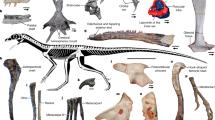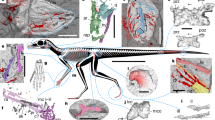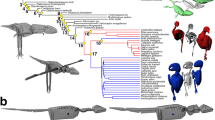Abstract
Comparison of birds and pterosaurs, the two archosaurian flyers, sheds light on adaptation to an aerial lifestyle. The neurological basis of control holds particular interest in that flight demands on sensory integration, equilibrium, and muscular coordination are acute1,2,3,4,5,6,7,8. Here we compare the brain and vestibular apparatus in two pterosaurs based on high-resolution computed tomographic (CT) scans from which we constructed digital endocasts. Although general neural organization resembles birds, pterosaurs had smaller brains relative to body mass than do birds. This difference probably has more to do with phylogeny than flight, in that birds evolved from nonavian theropods that had already established trends for greater encephalization5,9. Orientation of the osseous labyrinth relative to the long axis of the skull was different in these two pterosaur species, suggesting very different head postures and reflecting differing behaviours. Their enlarged semicircular canals reflect a highly refined organ of equilibrium, which is concordant with pterosaurs being visually based, aerial predators. Their enormous cerebellar floccular lobes may suggest neural integration of extensive sensory information from the wing, further enhancing eye- and neck-based reflex mechanisms for stabilizing gaze.
This is a preview of subscription content, access via your institution
Access options
Subscribe to this journal
Receive 51 print issues and online access
$199.00 per year
only $3.90 per issue
Buy this article
- Purchase on Springer Link
- Instant access to full article PDF
Prices may be subject to local taxes which are calculated during checkout




Similar content being viewed by others
References
Newton, E. T. On the skull, brain, and auditory organ of a new species of pterosaurian (Scaphognathus purdoni), from the Upper Lias near Whitby Yorkshire. Phil. Trans. R. Soc. Lond. B 179, 503–537 (1888)
Edinger, T. Das Gehirn der Pterosaurier. Z. Anat. Entwicklungsgesch. 82, 105–112 (1927)
Edinger, T. The brain of Pterodactylus. Am. J. Sci. 239, 665–682 (1941)
Jerison, H. J. Evolution of the Brain and Intelligence 482 (Academic, New York, 1973)
Hopson, J. A. in Biology of the Reptilia Vol. 9 Neurology A (eds Gans, C., Northcutt, R. G. & Ulinki, P.) 39–146 (Academic, New York, 1979)
Wellnhofer, P. The Illustrated Encyclopedia of Pterosaurs 192 (Crescent, New York, 1991)
Bennett, S. C. The osteology and functional morphology of the Late Cretaceous pterosaur Pteranodon. Part I. General description of osteology. Palaeontogr. Abt. A 260, 1–112 (2001)
Wharton, D. S. The Evolution of the Avian Brain 343. PhD thesis, Univ. Bristol (2002)
Larsson, H. C. E., Sereno, P. C. & Wilson, J. A. Forebrain enlargement among nonavian theropod dinosaurs. J. Vert. Paleontol. 20, 615–618 (2000)
Brochu, C. A. Progress and future directions in archosaur phylogenetics. J. Paleontol. 75, 1185–1201 (2001)
Kellner, A. W. A. Description of the braincase of two Early Cretaceous pterosaurs (Pterodactyloidea) from Brazil. Am. Mus. Novit. 3175, 1–34 (1996)
Lebedkin, S. Über die Lage des Canalis semicircularis lateralis bei Säugern. Anat. Anz. 58, 447–460 (1924)
Duijm, M. On the head posture of some birds and its relation to some anatomical features. Proc. Koninkl. Nederl. Akad. Wetensch. C 54, 202–211, 260–271 (1951)
Blanks, R. H. I., Curthoys, I. S. & Markham, C. H. Planar relationships of semicircular canals in the cat. Am. J. Physiol. 223, 55–62 (1972)
Erichsen, J. T., Hodos, W., Evinger, C., Bessette, B. B. & Phillips, S. J. Head orientation in pigeons: postural, locomotor and visual determinants. Brain Behav. Evol. 33, 268–278 (1989)
Spoor, F. & Zonneveld, F. Comparative review of the human bony labyrinth. Yearbook Phys. Anthropol. 41, 211–251 (1998)
de Beer, G. R. How animals hold their heads. Proc. Linn. Soc. Lond. 159, 125–139 (1947)
Chatterjee, S. & Templin, R. J. Posture, locomotion and paleoecology of pterosaurs. Geol. Soc. Am. Spec. Pap. (in the press)
Unwin, D. M., Lü, J. & Bakhurina, N. N. On the systematic and stratigraphic significance of pterosaurs from the Lower Cretaceous Yixian Formation (Jehol Group) of Liaoning, China. Mitt. Mus. Naturk. Berlin Geowiss. Reihe 3, 181–206 (2000)
Jones, G. M. & Spells, K. E. A theoretical and comparative study of the functional dependence of the semicircular canal upon its physical dimensions. Proc. R. Soc. Lond. B 157, 403–419 (1963)
Turkewitsch, B. G. Zur Anatomie des Gehörorgans der Vögel (Canales semicirculares). Z. Anat. Entwicklungsgesch. 103, 551–608 (1934)
Spoor, F., Bajpal, S., Hussain, S. T., Kumar, K. & Thewissen, J. G. M. Vestibular evidence for the evolution of aquatic behavior in early cetaceans. Nature 417, 163–166 (2002)
Butler, A. B. & Hodos, W. Comparative Vertebrate Neuroanatomy: Evolution and Adaptation 514 (Wiley-Liss, New York, 1996)
Winship, I. R. & Wylie, D. R. W. Zonal organization of the vestibulocerebellum in pigeons (Columba livia): I. Climbing fiber input to the flocculus. J. Comp. Neurol. 456, 127–139 (2003)
Wellnhofer, P. Die Rhamphorhynchoidea (Pterosauria) der Oberjura-Plattenkalke Süddeutschlands. Teil I. Allgemeine Skelettmorphologie. Palaeontogr. Abt. A 148, 1–33 (1975)
Kellner, A. W. A. & Tomida, Y. Description of a new species of Anhangueridae (Pterodactyloidea) with comments on the pterosaur fauna from the Santana Formation (Aptian-Albian), northeastern Brazil. Nat. Sci. Mus. Monogr. 17, 1–135 (2000)
Tischlinger, H. & Frey, E. Ein Rhamphorhynchus (Pterosauria, Reptilia) mit ungewöhnlicher Flughauterhaltung aus dem Solnhofener Plattenkalk. Archaeopteryx 20, 1–20 (2002)
Hurlburt, G. R. . Relative Brain Size in Recent and Fossil Amniotes: Determination and Interpretation 250. PhD thesis, Univ. Toronto (1996)
Romer, A. S. Osteology of the Reptiles 772 (Univ. Chicago Press, Chicago, 1956)
Proctor, N. S. & Lynch, P. J. Manual of Ornithology 340 (Yale Univ. Press, New Haven, 1993)
Acknowledgements
D. S. Berman (Carnegie Museum of Natural History) and J. Maisey (American Museum of Natural History) agreed to the loan and preparation of the pterosaur specimens. M. Atanassov assisted with body mass estimates and other morphometrics. Z. Zheng acid-prepared the fossils. M. Colbert, J. Humphries, R. Ketcham, and J. Maisano assisted with the CT scanning, data processing, and web delivery. Figures were drafted by R. Ridgely (Figs 2 and 3a, c) and K. McQuilkin (Fig. 3b, d, e and Fig. 4). We thank G. R. Hurlburt and D. S. Wharton for sharing data in their doctoral dissertations. We thank G. R. Hurlburt, P. M. O'Connor, E. Weber, and D. S. Wharton for fruitful discussion of pterosaurs and neuroscience, and R. J. Templin for providing aerodynamic expertise. The manuscript benefited from comments provided by D. M. Unwin & S. C. Bennett. Funding was provided by NSF grants to L.M.W. and T.R. and by Texas Tech University to S.C.
Author information
Authors and Affiliations
Corresponding author
Ethics declarations
Competing interests
The authors declare that they have no competing financial interests.
Supplementary information
41586_2003_BFnature02048_MOESM1_ESM.mov
Supplementary Movie: Anhan_waxspin.mov: QuickTime movie of reconstructed skull spinning axially around a longitudinal axis (MOV 1872 kb)
41586_2003_BFnature02048_MOESM2_ESM.mov
Supplementary Movie: Anhan_whorspin.mov: QuickTime movie of reconstructed skull spinning horizontally around a vertical axis (MOV 1782 kb)
41586_2003_BFnature02048_MOESM3_ESM.mov
Supplementary Movie: Anhan_wsagspin.mov: QuickTime movie of reconstructed skull spinning sagittally around a transverse axis (MOV 1770 kb)
41586_2003_BFnature02048_MOESM7_ESM.mov
Supplementary Movie: Anhan_RollSpinEndocast.mov: QuickTime movie of reconstructed endocast spinning horizontally around a vertical axis (MOV 561 kb)
41586_2003_BFnature02048_MOESM8_ESM.mov
Supplementary Movie: Anhan_YawSpinEndocast.mov: QuickTime movie of reconstructed endocast spinning axially around a longitudinal axis (MOV 722 kb)
41586_2003_BFnature02048_MOESM9_ESM.mov
Supplementary Movie: Rhamph_RollSpinHeadSkel.mov: QuickTime movie of reconstructed skull spinning axially around a longitudinal axis (MOV 1290 kb)
41586_2003_BFnature02048_MOESM10_ESM.mov
Supplementary Movie: Rhamph_YawSpinHeadSkel.mov: QuickTime movie of reconstructed skull spinning horizontally around a vertical axis (MOV 719 kb)
41586_2003_BFnature02048_MOESM11_ESM.mov
Supplementary Movie: Rhamph_PitchSpinHeadSkel.mov: QuickTime movie of reconstructed skull spinning sagittally around a transverse axis (MOV 1006 kb)
41586_2003_BFnature02048_MOESM15_ESM.mov
Supplementary Movie: Rhamph_YawSpinEndocast.mov: QuickTime movie of reconstructed endocast spinning horizontally around a vertical axis (MOV 661 kb)
41586_2003_BFnature02048_MOESM16_ESM.mov
Supplementary Movie: Rhamph_RollSpinEndocast.mov: QuickTime movie of reconstructed endocast spinning axially around a longitudinal axis (MOV 929 kb)
Rights and permissions
About this article
Cite this article
Witmer, L., Chatterjee, S., Franzosa, J. et al. Neuroanatomy of flying reptiles and implications for flight, posture and behaviour. Nature 425, 950–953 (2003). https://doi.org/10.1038/nature02048
Received:
Accepted:
Issue Date:
DOI: https://doi.org/10.1038/nature02048
This article is cited by
-
Neuroanatomy of the late Cretaceous Thescelosaurus neglectus (Neornithischia: Thescelosauridae) reveals novel ecological specialisations within Dinosauria
Scientific Reports (2023)
-
Independent origin of large labyrinth size in turtles
Nature Communications (2022)
-
Neuroanatomy of the nodosaurid Struthiosaurus austriacus (Dinosauria: Thyreophora) supports potential ecological differentiations within Ankylosauria
Scientific Reports (2022)
Comments
By submitting a comment you agree to abide by our Terms and Community Guidelines. If you find something abusive or that does not comply with our terms or guidelines please flag it as inappropriate.



